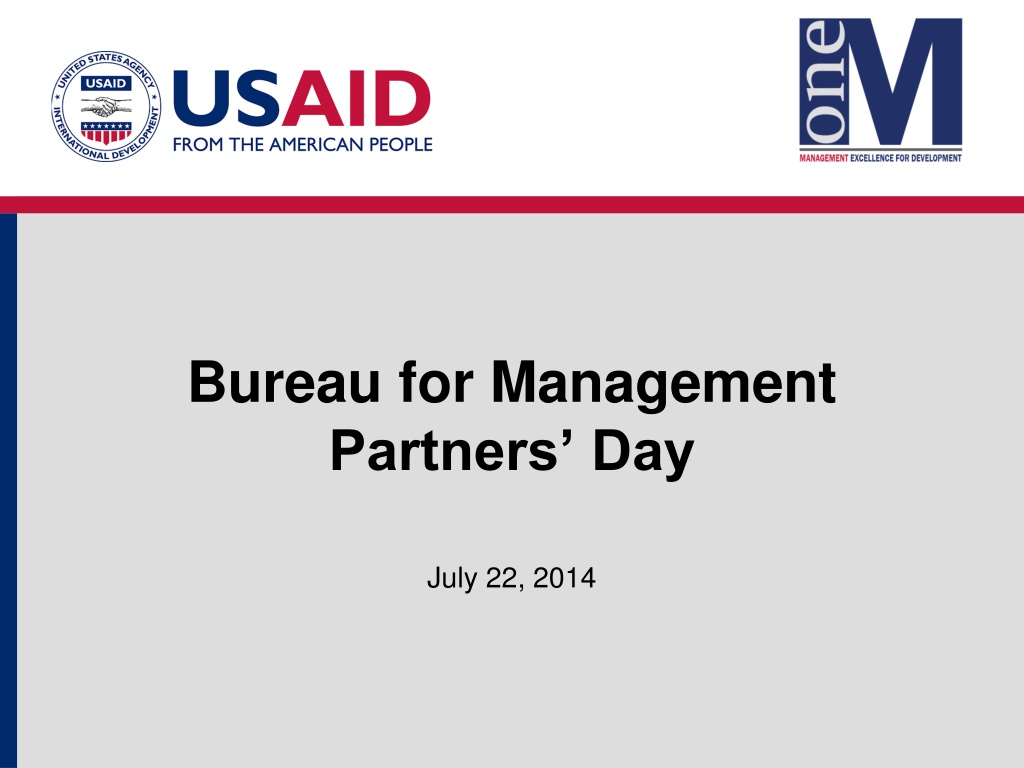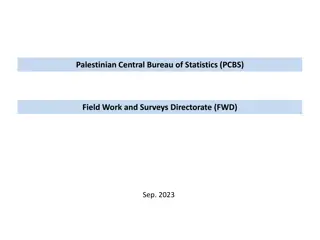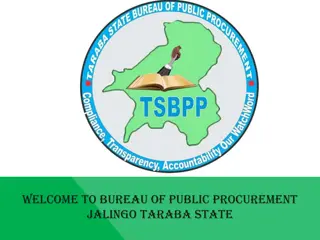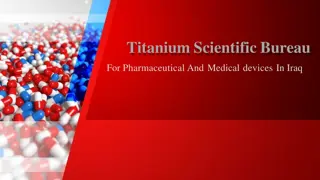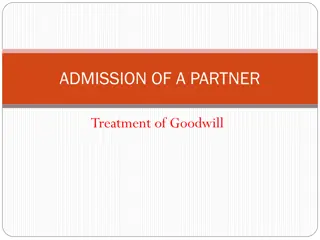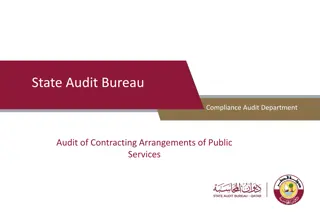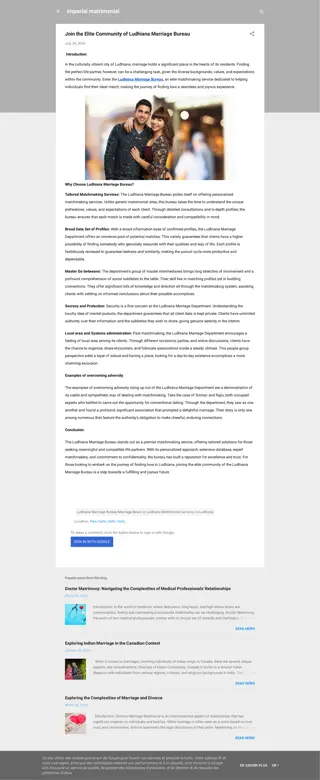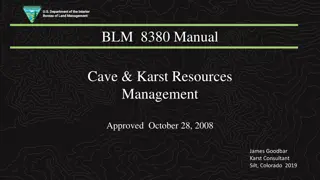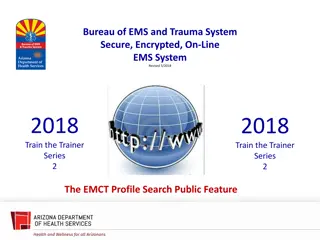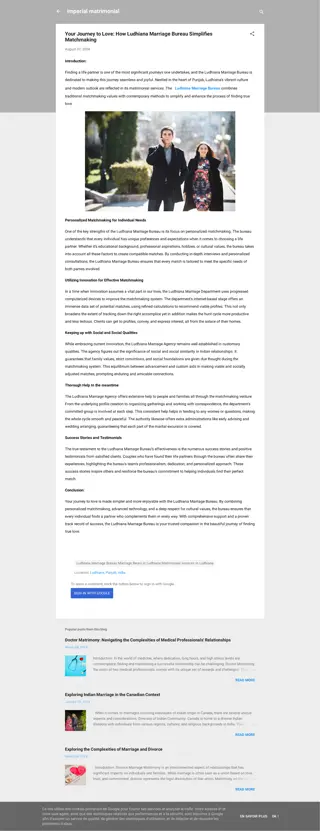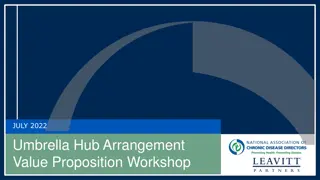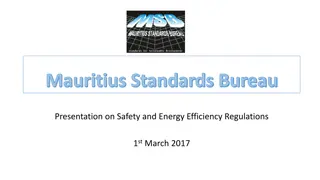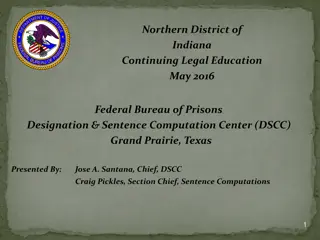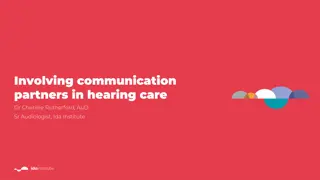Bureau for Management Partners Day
The Bureau for Management at USAID is the largest bureau, providing essential support for global operations in over 80 countries. It manages billions in acquisitions, strengthens financial management, promotes transparency, and enhances operational efficiency through mobile technologies. Key roles include Chief Financial Officer, Chief Information Officer, and more. Notable successes include managing operations during a shutdown, securing a clean audit report, and launching new initiatives.
Download Presentation

Please find below an Image/Link to download the presentation.
The content on the website is provided AS IS for your information and personal use only. It may not be sold, licensed, or shared on other websites without obtaining consent from the author.If you encounter any issues during the download, it is possible that the publisher has removed the file from their server.
You are allowed to download the files provided on this website for personal or commercial use, subject to the condition that they are used lawfully. All files are the property of their respective owners.
The content on the website is provided AS IS for your information and personal use only. It may not be sold, licensed, or shared on other websites without obtaining consent from the author.
E N D
Presentation Transcript
Bureau for Management Partners Day July 22, 2014
Did you know that the Bureau for Management Is the largest bureau at USAID Provides the financial, technological, space, and business support for our global operations in over 80 countries Employs personnel who carry out the following statutory responsibilities: Chief Financial Officer Chief Information Officer Chief Acquisition Officer Senior Real Property Officer Freedom of Information Act Officer Chief Information Security Officer Chief Sustainability Officer Performance Improvement Officer Regulatory Policy Officer 2
Notable Successes: In the last year, M Bureau has Managed Agency operations during the shutdown. Obligated more than $12 billion in acquisition and assistance, through more than 14,000 transactions. Strengthened USAID s financial management, securing a clean audit report on the Agency s financial statements. Become more transparent than ever, publicly sharing data and financial information in usable ways. Adopted more mobile technologies, ensuring greater mobility and continuity of operations. Launched new Intranet website to compliment the new Internet. Redoubled efforts to transform Agency business processes. 3
Assistant Administrator (AA/M) Deputy Assistant Administrators (3) Office of Management Policy, Budget & Performance (M/MPBP) Office of the Chief Information Officer (M/CIO) Office of the Chief Financial Officer (M/CFO) Office of Office of Acquisition & Assistance (M/OAA) Management Services (M/MS) Office of the Chief Financial Officer CFO Deputy CFO, HQ Deputy CFO, Overseas Office of the Chief Information Officer CIO Deputy CIO Office of the Director Director Deputy Director Office of the Director Director Deputy Director, ACTS Deputy Director, Operations Deputy Director, Foreign Ops Office of the Director Director Divisions Compliance ACTS: Cost, Audit & Support; Evaluation; Policy; Professional Development & Training Operations: E3; Food Security; Global Health; Regional & Management; Special Initiatives & Development Partners Transportation Divisions Administrative Management Budget Policy Performance Divisions Overseas Management HQ Management Travel & Transportation Information & Records Divisions Information Assurance IT Operations IT Service Delivery Information & Process Management Planning & Administration Divisions Audit, Performance & Compliance Central Accounting & Reporting Cash Mgmt. & Payment Financial Systems Washington Financial Services IPR Payroll
Looking Forward: Priorities M/MS, M/CIO, M/CFO Reducing our FOIA request backlog and continuing to improve Agency records management in an increasingly electronic environment Achieving more efficient use of Washington space Strategically managing our overseas footprint to provide effective program oversight, even in insecure environments Implementing a FISMA corrective action plan and continuing to improve information security Deploying IT systems to increase Agency productivity and efficiency Sustaining a clean audit opinion on Agency financial statements Institutionalizing M Bureau s efforts to use, strengthen, and partner with local actors in strategic, purposeful, and cost-effective ways 5
Looking Forward: Priorities M/AA, M/MPBP, and M/OAA Strategic alignment of operations with the Agency Mission and JSP Streamlined Reporting and Opening Agency Data to the Public Strategically managing Agency OE budget in the context of declining resources Deploying myUSAID.gov, our Intranet Modernization Initiative Improving Past Performance assessment report rates Reducing PALT (Procurement Administrative Lead Time) Supporting A&A process reform Continuing to deliver results on core operations while supporting Agency initiatives 6
Strategy Alignment : Management and Operations National Security Strategy identifies Development as one of the three pillars of national security and outlines: Providing appropriate authorities and mechanisms to implement and coordinate assistance programs and grow the civilian capacity required to assist government on a diverse set of issues. The use of inclusive interagency processes to achieve integration of our efforts to implement and monitor operations, policies and strategies. Presidential Policy Directive on Global Development (PPD 6) The President s approach to global development outlines: 3. A modern architecture that harnesses development capabilities spread across government in support of common objectives. 2. A new operational model that positions the United States to be a more effective partner and to leverage our leadership 1. A policy focused on sustainable development outcomes Joint Strategic Plan Strategic Goal 5: Modernize the Way We Do Diplomacy and Development A Secure Diplomatic and Development Platform Stakeholder Collaboration and Audience Engagement USAID Procurement Reform USAID Forward C. Identify and scale up innovative, breakthrough solutions to intractable development problems A. Deliver results on a meaningful scale through a strengthened USAID B. Promote sustainable development through high-impact partnerships USAID Corporate Objectives 1. Poverty and Hunger reduced by 20 percent in Feed the Future Focus Countries' Zones of Influence 4. Use the Transformative Power of Science, Technology, Innovation and Partnerships to Deliver more Effective, Cost- Efficient Results in Global Development 2. Global Health - Ending Preventable Maternal & Child Deaths and Creating an AIDS Free Generation 5. USAID is a strategically managed and operationally efficient and effective development partner 3. Cleaner Energy for More Inclusive, Sustainable Growth M Bureau Objectives Objective 1 (IT): All USAID employees have access to secure, mobile technologies and a modern intranet solution Objective 4 (Procurement): USAID's procurement (A&A) process is streamlined Objective 5 (S&T Inn. Part.) - Innovative procurement mechanisms and tools enable institute operations Objective 3 (Space): Washington-based staff have modern, functional and secure work space Objective 2 (Budget): OE Budgets are aligned and assessed quarterly
Bureau for Management Office of Management Policy, Budget and Performance (M/MPBP) Partners Day July 22, 2014
M/MPBP Mission & Vision Mission: To serve as the Agency s lead advisory office in support of management and operations by providing analytical expertise to modernize operational policy, budget, performance and business operations. Vision: To strive for operational excellence that strengthens and improves the Agency s programming and business processes. 10
M/MPBP Primary Responsibilities Manages the Agency s operating expense (OE) budget; Is responsible for Agency-wide management policy and performance functions; Responds to Congressional inquiries and concerns on management issues and ensures compliance with related legislative directives; and Prepares senior Agency officials to testify before Congress about management issues. 11
M/MPBP Challenges Delivering Management Excellence and Operational Efficiencies with Exceptional Quality Constrained budget environment Increased Demand for Specialized Skills High Volume of Incoming Projects and Initiatives Data Volume and Quality Hiring and Retaining Qualified Personnel with the Right Skill Mix Implementing & Maintaining Operational Changes 12
Did you know that M/MPBP Formulates and executes the Agency s operational budget of over $1.3 billion annually? Oversees the hiring of over 300 direct hire personnel in the bureau? Houses the Agency s Deputy Performance Improvement Officer and coordinates implementation of the President's Management Agenda at USAID? Coordinates the submission of over 100 statutory reports on an annual basis? Provides the quality control check for all corporate data? Uses cutting edge technology to collaborate with partners inside and outside the agency, tell the Agency's story and make our data available to the public. Is constantly innovating to improve the Agency operational policies and practices? 13
Contacts Angela McNerney, Office Director amcnerney@usaid.gov Colleen Allen, Deputy Office Director coallen@usaid.gov 14
Bureau for Management Office of the Chief Financial Officer (M/CFO) Partners Day July 22, 2014
M/CFO Mission Mission: To establish and maintain sound financial management practices that advance USAID's mission, goals and objectives through the timely collection and dissemination of accurate financial information, advisory, and analytical services. This is achieved by using a diverse workforce, innovative technologies, value-added business processes and the application of Federal financial standards. 16
M/CFO Vision Vision: To establish business processes enabling the worldwide CFO organization to be a value-added provider of financial information and services to our customers, partners and stakeholders by: Strengthening organizational competencies to effectively and efficiently manage business processes and information while focusing on fiscal integrity and internal controls Leveraging the combined strengths of our knowledge, leadership, and commitment to developing individuals Communicating strategies and messages to meet the needs of our customers, partners and stakeholders 17
M/CFO 2014 Priorities Sustain financial management and Local Solutions training for the Agency and the M Bureau Further institutionalize Local Solutions G2G support through integrating LS budget allocations, finalizing ADS 220 policy, revising and conforming LS training to revised policy, and filling LS vacant positions and training new employees Update ADS policies, standardize business practices, develop tools and leverage intranet to disseminate and store information 18
M/CFO Challenges Leadership Transition Balancing resources with existing and emerging reporting requirements and requests Remain effective and adapt to the evolving IT environment Increase customized financial info and data requests Continuous alignment of workforce analytical skills to meet customer needs and complex accounting requirements 19
Contacts Reginald Mitchell, Chief Financial Officer remitchell@usaid.gov Kent Kuyumjian, Deputy Chief Financial Officer, Headquarters kkuyumjian@usaid.gov Morgan Brady, Acting Deputy Chief Financial Officer, Overseas mjbrady@usaid.gov 20
Bureau for Management Office of the Chief Information Officer (M/CIO) Partners Day July 22, 2014
M/CIO Mission Mission: The Office of the Chief Information Officer (M/CIO) is responsible for information resources management that includes maintaining modern, secure and user-friendly technology for USAID bureaus and missions. 22
M/CIO 2014 Priorities: Information security improvements: IT governance processes & policies Security of our missions Security architecture Cloud-based social intranet platform: Connect, collaborate, and locate info & resources Investigating potential of partner collaboration IT Operations: Service delivery process & tools Enterprise Reporting Technology adoption OMB Initiatives: Smart Cards , Internet Protocol, optimized data center, mobile applications, open data 23
M/CIO Innovations On the leading edge of cloud implementation in USG Access from anywhere - virtual desktops Social Intranet platform Single sign-on Agile Development methodology 24
Implications for Partners: We look to you to know and follow USG and Agency privacy requirements as required by law Each of us employees and partners alike are required to follow all the same information security requirements and protect the Agency s information When any new Agency system is proposed, M/CIO must be involved in the earliest stages for review 25
Did you know that M/CIO The USAID IT enterprise has grown 25%+ in the last 5 years We have and manage: 50 FISMA-reportable systems Protect against 1,000s of information attacks daily 52 centrally managed systems 260 databases 15%+ of spending on cloud technologies in FY14, jumping to 26%+ in FY15 56,500+ service tickets every month Wireless networks at 19 missions 26
Contact Jay Mahanand, Acting Chief Information Officer jmahanand@usaid.gov 27
Bureau for Management Office of Management Services (M/MS) Partners Day July 22, 2014
M/MS Mission Mission: We are first and foremost a customer service office. Our principle customers are USAID staff, operating units and other USG colleagues in missions abroad. We also respond to the general public s requests for information. We partner with other USG and private companies to provide quality customer service. 29
M/MS Primary Responsibilities Manages domestic and overseas facilities and vehicle fleets Manages the Agency s mail and printing services Manages the Agency s travel, transportation and storage (household effects for Foreign Service Officers) and transit benefit programs Manages Emergency Preparedness and Response and Occupational Safety and Health programs Implements the Agency s world-wide records management program Manages the Agency s Freedom of Information Act (FOIA) program Manages recruitment, training, assignments and support of Agency Foreign Service Executive Officers Coordinates USAID s contributions to shared administrative support services at embassies 30
M/MS Priorities and Innovations Achieving greater efficiencies, effectiveness, and responsiveness in our service delivery Using IT tools to improve service delivery (e.g., travel, space management, information management) Consolidate operations with (space and some administrative services) with the Department of State at embassies Contribute to implementing USG open data policy to provide greater transparency and public access Achieve more efficient use of allocated space in Washington, DC through renovation and creative furniture solutions Generate cost savings by reducing storage of physical records and assets. 31
Did you know that M/MS Manages properties throughout the world totaling $3B, and 786,259 sq. ft. of property in the Washington Metropolitan area? Manages transit benefits for an estimated 1800 employees? Responds to an estimated 500 Freedom of Information Act requests annually? Reviewed 12,141 pages of records in response to FOIA requests in FY 2013? Manages the disposition of an estimated 10M pages of records annually, including the transfer of permanent records to the National Archives and Records Administration annually? Manages over 12,000 international and domestic travel transactions per year and processes nearly a thousand passport applications and visa transactions per year? Produces an estimated 200 publications (900,000 pages) annually in our in-house print shop? 32
Contact Lynn Winston, Acting Office Director lwinston@usaid.gov 33
Bureau for Management Office of Acquisition and Assistance (M/OAA) Partners Day July 22, 2014
M/OAA Mission & Vision Mission: Tocreate, award and administer projects to end extreme poverty and promote resilient, democratic societies while advancing our security and prosperity. We also aim to award packages that attract effective development partners Vision: To achieve value for money through well- designed and administered Acquisition & Assistance awards. 35
Award Cost Efficiency Study (ACES) Gift from Bill and Melinda Gates Foundation, USAID worked with a team of experts from the Oliver Wyman consulting firm to conduct the study A comprehensive initiative to analyze program designs, cost structures, and the Acquisition & Assistance (A&A) award process Made recommendations to help increase impacts and/or reduce costs without compromising the quality of USAID programs The study has been completed, recommendations have been issued to improve the efficiency of the award process and we have developed an implementation plan 36
Award Cost Efficiency Study (ACES) Ten cross cutting recommendations were made: Choice of Instrument (COI) - Working group established to revise policies and guidance by end of the calendar year. Improved management of awards Delegation of sub- awards and travel approvals under assistance to AORs Improved access to timely information New A&A Planning tool being launched in the fall to improve data quality and content for various features including the Business Forecast Streamlining A&A Process Developing business case for a fully electronic end-to-end award management system; (e.g, electronic proposals & evaluations, and post award admin) 37
Implementation of Uniform Requirements (OMB Super- circular) June 26 USAID forwarded its draft implementation of the OMB s Uniform Administrative Requirements, Cost Principles and Audit Requirements ( Uniform Requirements ) to OMB for review. The Agency intends to codify the Uniform Requirements at a new Code of Federal Regulations part: 2 CFR Part 700 The new regulation improves on current policy by: Eliminating duplicative and conflicting guidance; Focusing on performance over compliance for accountability; Encouraging efficient use of information technology and shared services; Providing for consistent and transparent treatment of costs; 38
Implementation of Uniform Requirements (OMB Super- circular) Limiting allowable costs to make the best use of Federal resources; Setting standard business processes using data definitions; Encouraging non-Federal entities to have family-friendly policies; Strengthening oversight; and Targeting audit requirements on risk of waste, fraud, and abuse Upon implementation, the new regulation will supersede, for USAID, OMB Circulars A-21, A-87, A-110, and A-122, Circulars A-89, A-102, and A-133; the guidance in Circular A-50 on Single Audit Act follow- up; and USAID s 22CFR Part 226 39
Implementation of Uniform Requirements (OMB Super- circular) USAID s implementation of the Uniform Requirements intends to include amendments to retain useful or necessary policy which has been already published in 22 CFR Part 226. This includes: Requirements concerning the use of metric system of measurement Contracting with Small and minority businesses, women s enterprises, and labor surplus area firms The ability to suspend or terminate awards in the national interest, administrative procedures regarding disputes and appeals and appeals USAID s marking and branding policy Looking forward to partner suggestions received during the rule making process with final rule projected for year end 40
Choice of Instrument (COI) ADS Chapter 201 on Planning underscores the critical importance of COI decisions: During the project design process, one of the most critical choices the project design team must make is selecting the optimal mix of implementing mechanisms ACES makes 10 process improvement recommendations to support increasing the Value-for-Money that USAID receives through A&A awards Select the most appropriate Instrument (i.e. Acquisition or Assistance) is one of the 10 ACES recommendations 41
Choice of Instrument (COI) The ACES consultants recommended that USAID: Update and clarify its instrument selection guidance, as the current federal-wide guidance does not provide clear guidance for USAID context To accomplish this, a multi-disciplinary team with M/OAA, GC, PPL, and other representatives will examine the ADS chapters relevant to COI: ADS 201 Planning ADS 300 on Agency A&A Planning ADS 304 on Selecting between A&A implementing instruments 42
Choice of Instrument (COI) These chapters and related guidance, templates and training will be updated and harmonized to: Clarify roles and responsibilities of Project Design Teams and Contracting Officers Address recent developments such as new case law on the use of intermediaries Standardize practices and documentation to achieve greater consistency across the Agency, both in Washington DC and the field 43
Procurement Administrative Lead Time (PALT) Monthly meetings with major Bureaus on A&A planning and tracking PALT, especially on large requirements Incorporated lessons learned early and continued engagement, PALTs signed off with M/OAA and Bureau leadership, weekly meetings on major requirements, sequestering tech panels, concurrent cost/technical reviews, and improved templates/guidance. Enhanced our system (GLAAS) to ensure more efficient and greater compliance with tracking PALTs. We realize a number of legacy procurements have continued to have lengthy PALTs, but lessons learned have been more fully incorporated in our more recent efforts such as Global Health Supply Chain. 44
Contacts Aman S. Djahanbani, Office Director adjahanbani@usaid.gov Mark Walther, Deputy Director mwalther@usaid.gov Deb Broderick, Deputy Director dbroderick@usaid.gov Sunil Xavier, Deputy Director sxavier@usaid.gov 45
